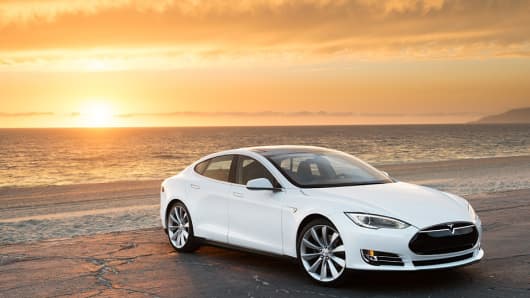The account in Sunday's Automobiles section of The Times detailing my troubled East Coast road trip in a Tesla Motors Model S sedan has generated quite a lot of commentary on the Internet, on Twitter and in the news media.
Elon Musk, the chief executive of Tesla, issued several tweets and was interviewed on CNBC Monday afternoon, where he disputed some aspects of the article.
He stated that my account was a "fake," that I had ignored explicit charging and driving instructions from Tesla personnel, that I had taken a "long detour" and that I had deliberately sabotaged my own trip. He said I had driven 10 miles an hour over the speed limit at times, and that he had logs that he said would show that I drove in a way that inevitably reduced the car's range.
NYTimes article about Tesla range in cold is fake. Vehicle logs tell true story that he didn't actually charge to max & took a long detour.
- Elon Musk (@elonmusk) 11 Feb 13
Let's answer these assertions in turn. My account was not a fake. It happened just the way I described it. When I first charged the car, which was equipped with the highest-capacity battery available, of 85 kilowatt-hours, at the Tesla Supercharger station in Newark, Del., I left it connected to the cable for 49 minutes until the dash display read "Charging Complete." The battery meter read 90 percent full, with a range of 242 miles.
I was not directed by anyone at Tesla at any time to then switch to the Max Range setting and wait to top off the battery. If I had, I might have picked up an additional 25 or so miles of range, but that would have taken as long as 30 additional minutes.
I was at that point 200 miles from the other East Coast Supercharger outlet in Milford, Conn., which I barely reached by driving 10 m.p.h. below the speed limit and turning off the battery-draining cabin-heating system.
(Mr. Musk's logs may show I hit 75 m.p.h. for a mile or two during my trip, although it was likely before, rather than after, the Newark stop. The car's power-usage meter clearly shows the major penalty driving at 75 inflicts on battery charge, discouraging any temptation to hooliganism in this 416-horsepower, $101,000 car. I drove more than 100 miles below 55 on cruise control to conserve power.)
Tesla data logging is only turned on with explicit written permission from customers, but after Top Gear BS, we always keep it on for media.
- Elon Musk (@elonmusk) 11 Feb 13
Tesla may contend that had I added the extra 25 miles of range, I would have been able to drive the speed limit (65 miles per hour) with a comfortable cabin temperature for 200 miles in 30-degree outside temperatures. Based on the rate at which the charge level was declining, I'm skeptical.
Mr. Musk has referred to a "long detour" on my trip. He is apparently referring to a brief stop in Manhattan on my way to Connecticut that, according to Google Maps, added precisely two miles to the overall distance traveled from the Delaware Supercharger to Milford (202 miles with the stop versus 200 miles had I taken the George Washington Bridge instead of the Lincoln Tunnel).
At that point, I was already experiencing anxiety about range and had called a Tesla employee from the New Jersey Turnpike to ask how to stretch the battery. She said to shut off the cruise control to take advantage of battery regeneration from occasional braking and slowing down. Based on that advice, I was under the impression that stop-and-go driving at low speeds in the city would help, not hurt, my mileage.
Before I set out from my home in suburban Washington, I informed Tesla that I intended to make a brief stop in New York and that I would spend the night in the vicinity of Milford rather than attempting to make it to Boston, which was theoretically possible with a full charge at Milford, although it was a bitterly cold night - and that clearly affects the car's range. I added 185 miles of range at Milford, knowing that I wouldn't need 242 or 265 miles before recharging the next morning.
When I parked the car for the night at a hotel, the range meter showed 90 miles remaining, and I was about 45 miles from the Milford Supercharger. As I recounted in the article, when I awoke the next morning the indicated range was 25 miles.
The rest of that story is told in the article, including a Tesla official's counsel, which I followed, that an hour of charging at the Norwich, Conn., utility would restore much of the range lost overnight, which had disappeared because of what he called a "software glitch."
A few more points:
Tesla made the offer to The Times to test the new East Coast Superchargers. The idea and the timing were theirs. (The Tesla public relations person who arranged the trip left Tesla last week and now works for Mr. Musk's space-launching venture, SpaceX.)
We tested the six-station Supercharger network on the West Coast in September; it worked super, and we said so.
Am not against NYTimes in general. They're usually fair & their own prev Tesla test drive got 300 miles of range! http://t.co/QWGetnNo
- Elon Musk (@elonmusk) 11 Feb 13
While Tesla officials and many armchair experts have said I should have accepted the time penalty to top off the battery in Delaware at the Max Range setting, Tesla warns specifically that this shortens the battery's life.
Virtually everyone says that I should have plugged in the car overnight in Connecticut, particularly given the cold temperature. But the test that Tesla offered was of the Supercharger, not of the Model S, which we already know is a much-praised car.


